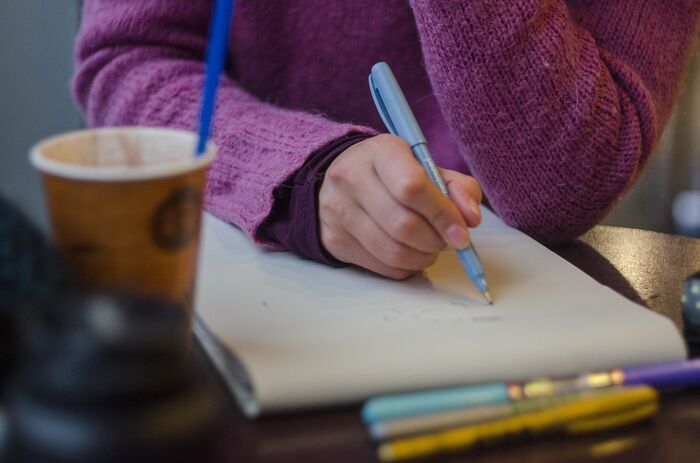Finding my place in the Fitzwilliam Museum
Connie de Pelet reflects on her special relationship with Cambridge’s beloved museum

For a few years, the Fitzwilliam Museum has been my place. It has been the backdrop to some of my most important moments here; a marbled place of milestones. Cambridge didn’t feel real for a long time when I was at school. I had never visited, knew nothing of Kings Chapel or supervisions. The first time I saw it was the day of my interview. I walked along Trumpington Road towards town; past the Fitzwilliam. Its pillars, carved ceilings, gold tipped railings. A manifestation of anything I thought I knew of Cambridge.
On my offer holder day, for a college I had never seen, my dad drove me up from Somerset. My apprehension stretched three and a half hours. When we arrived on the opposite side of town we had time to kill; we stopped me at the Fitzwilliam. I had just read an Ali Smith novel, How To Be Both, and was struck by the passage when the heroine bunks off school to sit in front of a painting that her mother had loved. It is a painting by Francesco del Cossa, of Saint Vincent Ferrer, dated between 1473-75.
"In the Fitzwilliam, I found something of a reassurance of my place here"
It is typical of its time, a religious piece in blues, reds and gold. She visits it seven times; looks at it; looks at the people looking at it. I slowed my breathing and thought about this. She grounded her feelings of grief in the painting; I read my own meanings into the oils around me. Smith had solidified something of the significance of the gallery space that I had always felt.

In November, I cycled to the Fitzwilliam with two new friends. We wandered round the first floor, sat on the cracked leather couches, stood in front of painted gentry. Some of the rooms are cased in pinkish marble, flanked by greens. We were studying Medieval literature, and reading of maidens cloaked in waved hair and wreathed with flowers. I recognised the strange romance of Chaucer’s Knight’s Tale in the Pre-Raphelite collections. Here hangs a painting by Sir John Everett Millais, one of the leading members of the movement, titled, The Bridesmaid (1851). It’s tiny, and coloured like a jewel: sapphires and ambers. In the centre, her hair streaked across most of the page, is a girl, her chin upturned. Her hair is flaming, her skin porcelain, her hands impossibly delicate. She holds a piece of wedding cake, enacting the old superstition that states an image of one’s future groom can be conjured in passing a morsel through a wedding ring nine times. There is something quite eerie about this painting, for all the richness of its colours. I told my friend it was my favourite painting in the Museum. She seemed surprised- but I thought it was beautiful. I bought a postcard of it in the gift shop, and, when I first went home for the Christmas holiday, I taped it to my wall. Something of Cambridge in my bedroom.
In February, I went to the Fitzwilliam’s annual Love Art After Dark Event with friends. There were specially opened exhibits, live jazz and a launch for a student-run magazine. I gave the caterer my laminated token and stood in an art gallery holding a glass of wine, thinking, this is it. This is what I wanted Cambridge to be: oil paintings and conversation. And for an evening at the Museum, it was.
Then, there was the exhibition inspired by the writings of Virginia Woolf in the first term of my second year. It showcased a spectrum of works by female artists, housed in rooms hand painted with line drawings of dancing women. I went alone, delighted.
Most recently, a few days post Half Way Hall, a friend of mine from home came to visit. I took him to the Fitzwilliam. My favourite room of oil paintings was closed, so we went downstairs and traced case after case of ceramics and glass work. We ended up in the Ancient Egypt room and talked about a school trip to a tiny Tutankhamun exhibit back in Somerset. The single room we had visited then could not compare to the selection of heavily decorated wooden coffins in front of us now. Problematic as a collection of another country’s culture may be, I felt a rush of awe. A sense of privilege at having access to such extraordinary relics of history. More than that, as I walked with my friend back down the steps at the front of the museum, I experienced one of those hot moments of realisation. I saw through his eyes something of what it was to be at Cambridge. In the Fitzwilliam, I found something of a reassurance of my place here.
 Features / Should I stay or should I go? Cambridge students and alumni reflect on how their memories stay with them15 December 2025
Features / Should I stay or should I go? Cambridge students and alumni reflect on how their memories stay with them15 December 2025 News / Cambridge study finds students learn better with notes than AI13 December 2025
News / Cambridge study finds students learn better with notes than AI13 December 2025 News / Dons warn PM about Vet School closure16 December 2025
News / Dons warn PM about Vet School closure16 December 2025 Comment / The magic of an eight-week term15 December 2025
Comment / The magic of an eight-week term15 December 2025 News / News In Brief: Michaelmas marriages, monogamous mammals, and messaging manipulation15 December 2025
News / News In Brief: Michaelmas marriages, monogamous mammals, and messaging manipulation15 December 2025









